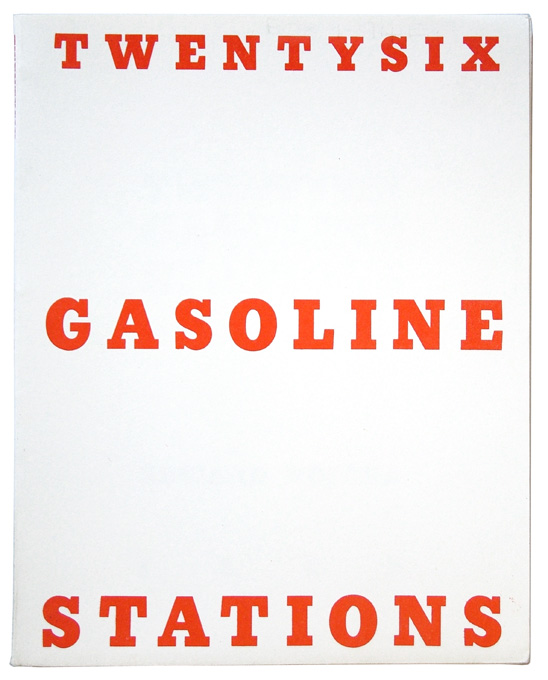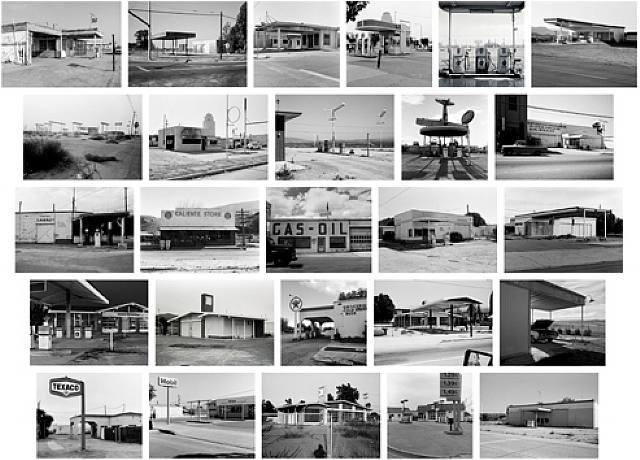Edward Joseph Ruscha IV (roo-SHAY; born December 16, 1937) is an American artist associated with the Pop art movement. He has worked in the media of painting, printmaking, drawing, photography, and film. Ruscha lives and works in Culver City, California.
http://en.wikipedia.org/wiki/Ed_Ruscha
A lot of critics have assigned a religious sub-text to the work, seeing a correlation between the gasoline stations and the 14 Stations of the Cross, traditionally the staging posts between Pilate's condemnation and the burial of Christ after His crucifixion on Calvary. Ruscha, a lapsed catholic, has gone some way to supporting this view in interviews:
There is a connection between my work and my experience with religious icons, and the stations of the cross and the Church generally, but it's in one of method, you know; I do have some flavors that come over, like the incense... we all go through stages... the attitude comes out of a whole style of living and then coming up with statements.The book has also been cited as an artist's book equivalent of a road movie, and as a pop version of Walker Evans' photos of America, such as his deserted gasoline station in 'Highway Corner Reedsville West Virginia, 1935'. (Although Ruscha has admitted knowledge of Evans' work, he has dismissed it as an influence.) The last image, of a Fina station, has been interpreted as a Duchampian pun on Fin (end).
Twentysix Gasoline Stations, a modest publication consisting of black and white photographs with captions, is an iconic artist book. The photographs are of petrol stations, along the highway between Ruscha’s home in Los Angeles and his parent’s house in Oklahoma City. Clive Phillpot, writer, curator and former Director of the Library at the Museum of Modern Art, New York, observes that the photographs are not reproduced in a linear sequence, with five photographs out of order. Taken from the highway and often including large areas of forecourt or road, the shots appear to be simply factual records of the petrol stations. Each opening of the book reveals one or two photographs in varying but repeated layouts, with the photographs set in relatively large areas of white space. The captions consist of the name of the petrol station and its location (for example, ‘Texaco, Sunset Strip, Los Angeles’ and ‘Flying A, Kingman, Arizona’). The front cover has the title printed in red as three separate lines, the stark brightness of the design muted by the wrap around protective cover. The book is the first in a sequence of photographic artist books by Ruscha.
Maria White
http://www.tate.org.uk/about/projects/transforming-artist-books/summaries/edward-ruscha-twentysix-gasoline-stations-1963
The book was arranged, then, so that our progress through its pages, left to right, was roughly analogous to our progress across a map from west to east, while the narrative obviously recounted a journey from Los Angeles to Oklahoma City and back. Thirteen tanks of gas one way and thirteen the other! How cool! I thought, How Pop-Joycean! And then, for reasons I can only attribute to Ruscha’s subtle genius, I counted the unnumbered pages. There were fifty-two of them, front and back, including the covers – twenty-six individual pages! Somehow, I had known there would be, and, clearly, if we moved through this book as we move across a map, as we move across America, and the number of physical pages corresponded to the number of objects depicted… well, hell, it all might mean something! The complete object might be speaking to us in some odd language of analogue and incarnation.
In that moment, I became an art critic – or, more precisely, an art dealer, since I bought all five books. Because it wasn’t just personal. Ruscha’s book nailed something that, for my generation, needed to be nailed: the Pop-Minimalist vision of the Road. Jack Kerouac had nailed the ecstatic, beatnik Road. Ken Kesey and Neal Cassady were, at that moment, nailing the acid-hippie Road, and now Ruscha had nailed the road through realms of absence – that exquisite, iterative progress through the domain of names and places, through vacant landscapes of windblown, ephemeral language.
Dave Hickey
http://www.americansuburbx.com/2009/10/theory-edward-ruscha-twentysix-gasoline.html
Ruscha originally conceived of the book as a way to report back the "news" by way of his numerous road trips across the U.S. on Route 66 between Oklahoma City and Los Angeles where he was located at the time. Inspiration for the title originally arose from a play of words, which the artist's graphic paintings are distinctly known for; he simply dug the word 'gasoline' and 'twentysix' seemed like the perfect written number to accompany it.
"Twentysix Gasoline Stations" was dry, deadpan and pretty much boring. As Ruscha commented above there is no aesthetic glorification in the depiction of the imagery, just a poker-faced collection of unremarkable snapshots of roadside gas stations arranged in a visual photo-conceptual typology of sorts. The photographs therein were unprofessionally photographed and deliberately anti-aestheticized. Accordingly the book's cover title was typeset as three centered lines of capitalized type whose only extravagance was its bright red color appearing on a white ground. The presentation of this puzzling little book with its interior series of black and white photographs has certainly created a fuss over the years since it was first published in 1962 from both art critics and the art community.
Indeed, critical response to Ruscha's series of mass-produced, ubiquitous artist photobooks has been at times downright hostile, for instance consider conceptual photographer, Jeff Wall's commentary describing Ruscha's books; "Only an idiot would take pictures of nothing but the filling stations, and the existence of a book of just those pictures is a kind of proof of the existence of such a person."
Kim Stringfellow
http://www.kcet.org/arts/artbound/counties/los-angeles/ed-ruscha-photobooks.html






No comments:
Post a Comment